Even if you've never heard of structured cabling before, you still rely on the results of their work every day. Within the walls of almost any modern building - be it an apartment building, data center, large office, multifunctional complexes, and sometimes even residential buildings - you can find networks of cables and wires that support communication between hundreds of devices.
Structured cabling systems support a building's telephone and telecommunications lines, transfer data between computer systems, connect individual rooms and offices to fiber optic networks, and enable audio and video communications. Such systems do all this without interruption and much faster than conventional systems with an arbitrary structure. SCS are so important to ensure uninterrupted network communications that they are called "the most important networking tool you've never heard of."

P2P vs. structured cabling
Structured cabling systems have replaced conventional P2P (Point-to-point) systems. This old method of organizing network infrastructure is to connect one network element (server, switch or device) directly to another element using a patch cord. Twenty years ago, this simple solution did a good job of quickly and easily deploying a network. However, nowadays, networks continue to grow, and the transfer of huge amounts of data is an absolute must for many enterprises. Under these conditions, the use of conventional P2P systems leads to problems associated with the need to expand and complicate your network infrastructure, as well as impose huge costs on your company due to the need to maintain thousands of P2P connections.
To solve these problems, many companies have resorted to the only sensible solution - the transition to structured cabling, in which all devices, instead of connecting directly to each other, are connected together through a single communication network.

Benefits of structured cabling
Why is the transition to SCS a good investment? There are many reasons for this. Structured cabling systems:
Pay off. Moving to cabling structured systems can be expensive, but the investment will ultimately pay off by improving the efficiency of your employees and reducing IT costs.
Reduces the time it takes to repair devices. Due to the fact that SCS is divided into groups of devices connected to a separate patch panel, it becomes easier for your IT staff to identify and solve existing problems. An added benefit is that users can continue to operate the device even if the patch panel is being serviced.
Facilitate future system modifications. Average cable lifespan is 15 years, which is two to three times longer than most devices. The cabling systems installed today will last you a long time and will need to serve multiple generations of devices. Nobody knows how much your business will grow and what devices you will need in the future. This is why the use of structured cabling systems ensures that you are ready for future network infrastructure upgrades.
Provide great flexibility. Adding new devices to the network becomes much easier when the enterprise uses structured cabling. Instead of using a new cable for each new device to connect it to a server or switch, your IT staff can simply plug the device into the nearest patch panel. Disconnecting devices is just as easy. You no longer need to find and disconnect individual cables as you did with P2P connections.



